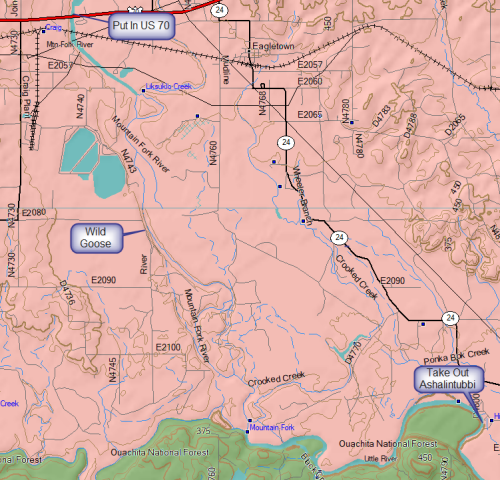

| Date: June 13-14, 2020 | Sponsor: DDRC |
| River: Lower Mountain Fork and Little River in OK | Trip Leader: Dale Harris |
| Reach: US Highway 70 to Ashalintubbi | Phone: 972-514-2633 |
| Difficulty: Flatwater - no rapids * (See scale below) | E-mail: President@down-river.com |
Rendezvous: Wild Goose Canoe Rental |
|
| Campground: Wild Goose Campground |
Overnight Trip on the Lower Mountain Fork
|
Trip Description: Come paddle the beautiful Lower Mountain Fork River from U.S. 70
Ashlantubbi public boat ramp – 13 miles over two days. The Lower Mountain
Fork River is a gravel bottom river that typically has cool clear water with
lots of gravel bars. It has small rapids and riffles which makes it a fun
paddle.
Gear Requirements: Bring boats (just about any seaworthy craft will do for this trip), PFD's (lifejackets), paddles (a spare is recommended), a whistle or other signalling device, throwbag, tent, ground pad, sleeping bag, clothing for hot, cold, wet and dry conditions, camp chair, headlamp, plate(s), flatware, drinking cup, personal toiletries and other items that you may want to have with you. A small cooler for drinks and lunches to be carried in your boat would be recommended. Meals: Everyone will be responsible for their own food. There will be a pot luck dinner on Saturday night. Bring plenty of beverages, but remember - NO GLASS OR FOAM POLYSTYRENE STYROFOAM CONTAINERS! Back-up Plans: There is no backup plan for this trip. If, for any reason, the trip on the Sabine cannot be made, then it will be cancelled. Driving Directions: Directions: Go east on IH 30 out of Dallas to US 259 N Follow US 250 to Broken Bow, OK and turn right on US 70 Eats Take U.S. 70 East 5.8 miles out of Broken Bow, Oklahoma. Turn right on Craig Road and go ~3 miles south. The road makes a 90 degree curve, so exit to your left and continue south for ~1 mile. Take a left at the “T” intersection and go ~ 2 miles. Stay left at the next curve and go 4/10 mile. It is on the right. Watch for the signs.
|
 |
| * International Scale of River Difficulty
Class I: Easy. Fast moving water with riffles and small waves. Few obstructions, all obvious and easily missed with little training. Risk to swimmers is slight, self-rescue is easy.
Class II: Novice. Straightforward rapids with wide, clear channels which are evident without scouting. Occasional maneuvering may be required, but rocks and medium sized waves are easily missed by trained paddlers. Swimmers are seldom injured and group assistance, while helpful, is seldom needed. Class III: Intermediate. Rapids with moderate, irregular waves which may be difficult to avoid and which can swamp an open canoe. Complex maneuvers in fast current and good boat control in tight passages or around ledges are often required; large waves or strainers may be present but are easily avoided. Strong eddies and powerful current effects can be found, particularly on large-volume rivers. Scouting is advisable for inexperienced parties. Injuries while swimming are rare; self-rescue is usually easy but group assistance may be required to avoid long swims. Class IV: Advanced. Intense, powerful but predictable rapids requiring precise boat handling in turbulent water. Depending on the character of the river, it may feature large, unavoidable waves and holes or constricted passages demanding fast maneuvers under pressure. A fast, reliable eddy turn may be needed to initiate maneuvers, scout rapids, or rest. Rapids may require "must" moves above dangerous hazards. Scouting is necessary the first time down. Risk of injury to swimmers is moderate to high, and water conditions may make self-rescue difficult. Group assistance for rescue is often essential but requires practiced skills. A strong eskimo roll is highly recommended. Class V: Expert. Extremely long, obstructed, or very violent rapids which expose a paddler to above average endangerment. Drops may contain large, unavoidable waves and holes or steep, congested chutes with complex, demanding routes. Rapids may continue for long distances between pools, demanding a high level of fitness. What eddies exist may be small, turbulent, or difficult to reach. At the high end of the scale, several of these factors may be combined. Scouting is mandatory but often difficult. Swims are dangerous, and rescue is difficult even for experts. A very reliable eskimo roll, proper equipment, extensive experience, and practiced rescue skills are essential for survival. Class VI: Extreme. One grade more difficult than Class V. These runs often exemplify the extremes of difficulty, unpredictability and danger. The consequences of errors are very severe and rescue may be impossible. For teams of experts only, at favorable water levels, after close personal inspection and taking all precautions. This class does not represent drops thought to be unrunnable, but may include rapids which are only occasionally run. |
|
Copyright © 1996-2011, Dallas Downriver Club. All rights reserved.
You may not copy, distribute, or use these materials except for your personal, non-commercial use. Any trademarks are the property of their respective owners. All original photographic images are the exclusive property of Dallas Downriver Club or other designated photographers and may not be copied, duplicated, reproduced, distributed or used in any manner without prior written permission of the copyright owner under penalty of US and International laws and treaties. |